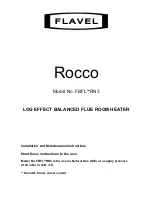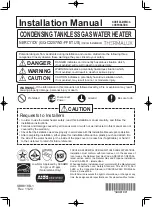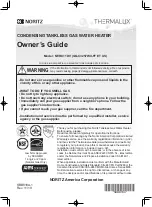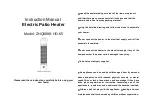
13
CLOSED WATER SYSTEMS
Water supply systems may, because of code requirements
or such conditions as high line pressure, among others, have
installed devices such as pressure reducing valves, check
valves, and back flow preventers. Devices such as these cause
the water system to be a closed system.
THERMAL EXPANSION
As water is heated, it expands (thermal expansion). In a closed
system the volume of water will grow when it is heated. As the
volume of water grows there will be a corresponding increase
in water pressure due to thermal expansion. Thermal expansion
can cause premature failure (leakage) of storage tanks, water
heaters and HPWH components such as the condenser.
Leakage caused by thermal expansion is not covered under the
HPWH limited warranty.
Thermal expansion can also cause intermittent Temperature-
Pressure Relief Valve operation: water discharged due to
excessive pressure build up. The Temperature-Pressure Relief
Valve is not intended for the constant relief of thermal expansion.
A properly sized thermal expansion tank must be installed on
all closed systems to control the harmful effects of thermal
expansion. Contact a local plumbing service agency to have a
thermal expansion tank installed on all closed water systems.
MIXING VALVES
Water temperature over 125°F (52°C)
can cause severe burns instantly
resulting in severe injury or death.
Children, the elderly and the
physically or mentally disabled are at
highest risk for scald injury.
Feel water before bathing or
showering.
Temperature limiting devices such as
mixing valves must be installed
when required by codes and to
ensure safe temperatures at fixtures.
Water heated to a temperature which will satisfy clothes washing,
dish washing, and other sanitizing needs can scald and cause
permanent injury upon contact. See Table 5.
Some people are more likely to be permanently injured by hot
water than others. These include the elderly, children, the infirm
and the physically/mentally disabled. The Table below shows
the approximate time-to-burn relationship for normal adult skin.
If anyone using hot water provided by the water heater being
installed fits into one of these groups or if there is a local code
or state law requiring a certain water temperature at the point of
use, then special precautions must be taken.
In addition to using the lowest possible temperature setting that
satisfies the demand of the application a Mixing Valve should be
installed upstream from the building fixtures or at the hot water
taps to further reduce system water temperature.
Mixing valves are available at plumbing supply stores. Consult
a Qualified Installer or Service Agency. Follow the mixing valve
manufacturer’s instructions for installation of the valves.
WATER PIPING
Read all installation requirements in this manual before
installation begins.
The water piping installation must conform to these instructions
and to all local and national code authority having jurisdiction.
Costs to diagnose, perform service and repair damage caused
by installation errors are not covered under the limited warranty.
Costs to correct installation errors are not covered under the
limited warranty.
MAXIMUM PIPE LENGTH
Factory installed pumps will provide the specified water flow for
up to a total of 50 equivalent feet of water piping between the
HPWH and the storage tank. Example: 25 equivalent feet of inlet
(return) piping and 25 equivalent feet of outlet (supply) piping.
Exceeding these maximum lengths will cause the unit to
malfunction and control system lock outs.
MINIMUM PIPE SIZE
The inlet (return) and outlet (supply) water piping installed
between the HPWH unit and the storage tank must not be smaller
than the water connection sizes on the HPWH. See Table 4 for
water line connection sizes and water flow rates.
Water line sizing is a critical installation requirement. Installing
undersized water piping between the storage tank and the
HPWH unit will cause insufficient water flow and will have an
adverse impact on performance and equipment life.
TABLE 4
WATER CONNECTIONS AND FLOW
UNIT
GPM LPM
CONNECTION SIZE (INCH)
AWH-35
7
27
1
AWH-55
11
42
1
AWH-75
15
57
1.5
AWH-100
20
76
1.5
AWH-115
23
87
1.5
AWH-140
28
106
2
AWH-170
34
129
2
PIPE SUPPORT
All water piping must be properly supported per local code
requirements.
PIPE INSULATION
All piping installed between the HPWH unit and the storage tank
must be insulated.
COLD WATER SUPPLY
Cold water supply lines should not be connected directly to the
HPWH inlet or T fitted into the inlet (return) water piping. The cold
water supply lines should be connected directly to the storage
tank only. See Inlet & Outlet Water Temperature on page 10
and Figure 7 and Figure 8 on page 18.
WATER PRESSURE
System water pressure should be maintained between 40 and 60
PSI. Local code may require, and the manufacturer recommends,
installing a pressure reducing valve (PRV) in the cold water
supply to the building to maintain consistent water pressure.
Summary of Contents for AWH-35
Page 2: ......
Page 32: ...UNIT WIRING DIAGRAMS FUSE SIZES 208 230 VAC SINGLE PHASE 60 HZ 32...
Page 33: ...UNIT WIRING DIAGRAMS FUSE SIZES 208 230 VAC THREE PHASE 60 HZ AWH 35 AWH 55 and AWH 75 only 33...
Page 34: ...UNIT WIRING DIAGRAMS FUSE SIZES 208 230 VAC THREE PHASE 60 HZ only 34...
Page 35: ...UNIT WIRING DIAGRAMS FUSE SIZES 460 VAC THREE PHASE 60 HZ 35...
Page 36: ...UNIT WIRING DIAGRAMS FUSE SIZES 460 VAC THREE PHASE 60 HZ only 36...














































